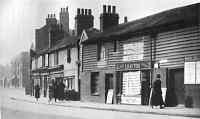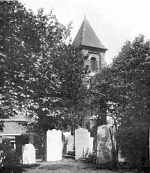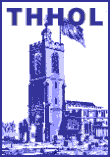 Very
few traces are left of the sometime rural village which, being contiguous to the Priory, was
included in the Upper Manor. Some old houses in poor condition remain in High Street (the middle
of which marks the boundary between the respective parishes of Bromley and Bow) but these survivals
are unattractive specimens of the class of cottage property that dates back to the opening years
of the eighteenth century, and are interesting only on account of their age. They afford little
evidence concerning the village in former days, but in the neighbourhood of the church, despite
the close-by recently erected dwellings, there is an aspect suggestive of a vanished past.
Very
few traces are left of the sometime rural village which, being contiguous to the Priory, was
included in the Upper Manor. Some old houses in poor condition remain in High Street (the middle
of which marks the boundary between the respective parishes of Bromley and Bow) but these survivals
are unattractive specimens of the class of cottage property that dates back to the opening years
of the eighteenth century, and are interesting only on account of their age. They afford little
evidence concerning the village in former days, but in the neighbourhood of the church, despite
the close-by recently erected dwellings, there is an aspect suggestive of a vanished past.Here opposite the churchyard was The Green, in the centre of which stood the most ancient of legal institutions in our country, the Pound. It was, however, afterwards removed to Devons Lane. Near the original position of the Pound was the village pump, the disappearance of which was, apart from the danger to the strayed reveller, a matter of local concern. At a vestry meeting held on 26 December 1752 it was
'Resolved that it be recommended to the Surveyors to put some posts and rails round the Well near where the Pound stood, least any accident should happen, or fill it up, unless the Lord of the Manor will erect a pump there as used to be for the benefit of the poor.'
The amenities of life in these 'good old days' included the bowling-green, the stocks, the whipping-post and the ducking-stool, all of which contributed to the gaiety and well-being of the little community. The bowling-green was in Devons Lane (now Road) near the modern 'Rose and Crown,' whose former sign was that of 'The Bowling Green Inn.' For the maintenance of good behaviour the churchwarden's expenses in 1671 included the following item :-
'Pd. for making ye Stocks and Whipping Post £2 17s. -.'
Fifty years afterwards two Justices of the Peace, namely Sir Charles Peers and Elias Russell, Esquire (both inhabitants of this parish) had occasion to issue the following order:-
'To the Constable and Churchwarden of the Parish of Bromley St. Leonards in the said County:
'Whereas the stocks in your said parish are become useless of their decay; these are therefore in his Maj'ties name to will and require you and each of you on sight hereof, to cause the Stocks to be rebuilt and substantially set up in the cross way at the end of the lane (Back Alley) going in to the fields near the Bowling Green in your said parish. And for your so doing this shall be your Warrant. Dated this 28th day of Novr. Anno Domino, 1722.'
The ducking-pond was situated in the middle of a large field on the south side of Devons Lane, represented nowadays by a spot halfway down Glaucus Street. This mode of punishment dates back to Saxon times and was judicial, not domestic, in character. The ducking-stool was a chair fastened at the end of a long pole used as a lever to lower and raise in and out of the water the infuriated culprit, who was tied to the seat during the ceremony not to her liking. The third immersion usually proved efficacious. Like the other objects provided for the vindication of law and order, every parish was bound to keep this machine in good condition in readiness for the punishment of common scolds and other troublesome women, thereby causing the very sight of it to have a deterrent effect upon those who would otherwise have conducted themselves as a public nuisance.
It would be libelling the poor and honest inhabitants of Bromley if it were thought that the stocks and whipping-post were merely set up for their particular regard. The vagrant, male or female, the rogue and vagabond were undesirable visitors, and woe betide them if they remained long in the parish. The eighteenth century brought into the neighbourhood, especially on Sundays, many tippling parties, and others who frequented Bromley Lock to enjoy their leisure in the manner of those days in over-eating and over-drinking. Here, as at Clay Hall in Old Ford, a speciality for gluttons was eel pie, of which the River Lee afforded the principal ingredient in abundance. To many of our readers the treatment meted out to those who misbehaved themselves may seem barbarous, but it should be remembered that no other method of punishment then was available. There were no prisons to which they could be committed for minor offences, and therefore compulsory confinement would be restricted only to temporary restraint. The penalty for tippling was a fine of 3s. 4d., or four hours in the stocks.
The village, which was small in size but big in pride, was dominated in an autocratic and benevolent way for many years by the resident Lords of the Manor, and was a law unto itself in all matters ecclesiastical, parochial, and social. It was situated in and about the Upper (or High) Street and Four Mill Street, now renamed St. Leonard's Street. That the name of the latter should have been changed is a matter for regret, for the retention of its original description would have perpetuated the memory of an historical fact. Among the records of the time of Richard I reference is made to 'three acres of land in a field called 'Dune' by the four mills.' Where these two streets converge was called, a century ago, the Broadway. There, opposite St. Leonard's Street, stands an eighteenth-century house of three storeys which was purchased in 1857 as Parsonage House for the incumbent of Bromley St. Leonard. The price paid for these freehold premises was £950, and the repairs were executed 'in a very first rate and substantial manner' at a cost of £600. The money in payment was raised by subscription to which Mr. J. Walter, M.P., of The Times, who was then lay rector and impropriator, gave £500.
The house was formerly occupied by a Mrs. Hodgson, and in her time there were some lofty trees in front of it. To this lady the churchyard owes the avenue of trees which is an admired feature in it.
 On
a hot summer's day to turn into the churchyard - very little more than an acre in extent - is
to come into a pleasant retreat amid the memorials of those 'late of this parish.' Beneath the
rich foliage of the trees that give an agreeable shade, an unexpected calm and tranquillity
prevail which are remarkable because of the proximity of an industrial and populous district.
Here and there may be seen a variety of seventeenth and eighteenth century monuments, many of
Huguenot families, with altar tombs and headstones, some of considerable beauty, or with carving
of interest. Within the church that might well be imagined as standing in the country, are several
noble monuments which were removed from the ancient edifice that previously stood on the same
site. Among them is one, composed of alabaster and marble, depicting William Ferrars and Jane
(Van Lore) his wife and child. He died in 1625 possessed of the Lower Manor. Others are of the
Jacob, Roberts, and Benson families, who successively held the Upper Manor, all exhibiting beauty
of design and artistic execution. An interesting memorial (1680) is that of Sir Richard Munden,
'one of his Majesties Captains at Sea,' who captured St. Helena. On the floor of the tower,
partly hidden by the stairs, is a slab of Purbeck marble about six feet long and three feet
wide, in which was embedded a brass showing figures of John de Bohun, Earl of Hereford and of
Essex, and his wife, who were buried in the Priory six hundred years ago.
On
a hot summer's day to turn into the churchyard - very little more than an acre in extent - is
to come into a pleasant retreat amid the memorials of those 'late of this parish.' Beneath the
rich foliage of the trees that give an agreeable shade, an unexpected calm and tranquillity
prevail which are remarkable because of the proximity of an industrial and populous district.
Here and there may be seen a variety of seventeenth and eighteenth century monuments, many of
Huguenot families, with altar tombs and headstones, some of considerable beauty, or with carving
of interest. Within the church that might well be imagined as standing in the country, are several
noble monuments which were removed from the ancient edifice that previously stood on the same
site. Among them is one, composed of alabaster and marble, depicting William Ferrars and Jane
(Van Lore) his wife and child. He died in 1625 possessed of the Lower Manor. Others are of the
Jacob, Roberts, and Benson families, who successively held the Upper Manor, all exhibiting beauty
of design and artistic execution. An interesting memorial (1680) is that of Sir Richard Munden,
'one of his Majesties Captains at Sea,' who captured St. Helena. On the floor of the tower,
partly hidden by the stairs, is a slab of Purbeck marble about six feet long and three feet
wide, in which was embedded a brass showing figures of John de Bohun, Earl of Hereford and of
Essex, and his wife, who were buried in the Priory six hundred years ago.
In leaving the churchyard, a clear and frosty night in the winter of 1881 comes to mind, when the High Street, perhaps then mean looking in the day, but certainly better than it is now, was seen in the glorious moonlight. The ancient timber-built 'Seven Stars' inn, with its overhanging upper storey and gabled roof, presented together with the adjacent wooden-houses, an unforgettable, picturesque and stage-set scene. The inn that had witnessed the changes during three hundred years was doomed at last itself to change. In 1895 it was pulled down. According to a local tradition, which may for once in a way be accepted as reasonable, it was built, with the buildings alongside and extending to Edgar Road, in 1606, at the same time as the adjoining premises known as the Old Palace, with the intention of providing servants' and retainers' quarters, domestic offices and outhouses.
by Sydney Maddocks
Continue to: "Bromley Saint Leonard : Tudor House, Lower Manor'
